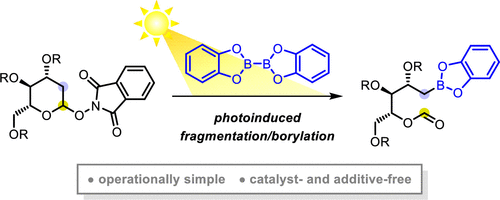当前位置:
X-MOL 学术
›
Org. Lett.
›
论文详情
Our official English website, www.x-mol.net, welcomes your feedback! (Note: you will need to create a separate account there.)
Photoinduced Fragmentation Borylation of Cyclic Alcohols and Hemiacetals.
Organic Letters ( IF 5.2 ) Pub Date : 2020-09-09 , DOI: 10.1021/acs.orglett.0c02513 Chao Shu 1 , Rudrakshula Madhavachary 1 , Adam Noble 1 , Varinder K Aggarwal 1
Organic Letters ( IF 5.2 ) Pub Date : 2020-09-09 , DOI: 10.1021/acs.orglett.0c02513 Chao Shu 1 , Rudrakshula Madhavachary 1 , Adam Noble 1 , Varinder K Aggarwal 1
Affiliation

|
A visible-light photoinduced fragmentation borylation of O-phthalimido cycloalkanols with bis(catecholato)diboron is described. Structurally diverse keto and formyloxy alkyl boronic esters are shown to be conveniently prepared by radical-mediated ring opening of cyclic alcohols and hemiacetals, respectively. The reactions proceed under mild conditions in the absence of additives or photocatalysts, display excellent functional group tolerance, and are shown to allow cleavage of 4-, 5-, 6-, and 7-membered ring substrates. The mechanism proceeds via sequential homolytic N–O and C–C bond cleavages, the latter of which involves β-scission of an alkoxy radical, generating a carbonyl and an alkyl radical that is trapped by the diboron reagent. Spectroscopic studies suggest direct photoexcitation of either the phthalimide or diboron substrates with blue light can initiate a radical chain mechanism.
中文翻译:

环醇和半缩醛的光诱导碎裂硼化。
O的可见光光致碎裂硼化描述了具有双(邻苯二酚)二硼的邻苯二甲酰亚胺基环烷醇。分别通过环状醇和半缩醛的自由基介导的开环,可以方便地制备结构多样的酮基和甲酰氧基烷基硼酸酯。反应在没有添加剂或光催化剂的条件下在温和条件下进行,显示出极好的官能团耐受性,并显示可裂解4、5、6和7元环底物。其机理是通过顺序的均相N–O和C–C键裂解来进行的,后者的裂解涉及烷氧基的β断裂,生成羰基和被二硼试剂捕获的烷基。光谱研究表明,用蓝光直接对邻苯二甲酰亚胺或乙硼烷底物进行光激发可引发自由基链机制。
更新日期:2020-09-20
中文翻译:

环醇和半缩醛的光诱导碎裂硼化。
O的可见光光致碎裂硼化描述了具有双(邻苯二酚)二硼的邻苯二甲酰亚胺基环烷醇。分别通过环状醇和半缩醛的自由基介导的开环,可以方便地制备结构多样的酮基和甲酰氧基烷基硼酸酯。反应在没有添加剂或光催化剂的条件下在温和条件下进行,显示出极好的官能团耐受性,并显示可裂解4、5、6和7元环底物。其机理是通过顺序的均相N–O和C–C键裂解来进行的,后者的裂解涉及烷氧基的β断裂,生成羰基和被二硼试剂捕获的烷基。光谱研究表明,用蓝光直接对邻苯二甲酰亚胺或乙硼烷底物进行光激发可引发自由基链机制。


























 京公网安备 11010802027423号
京公网安备 11010802027423号